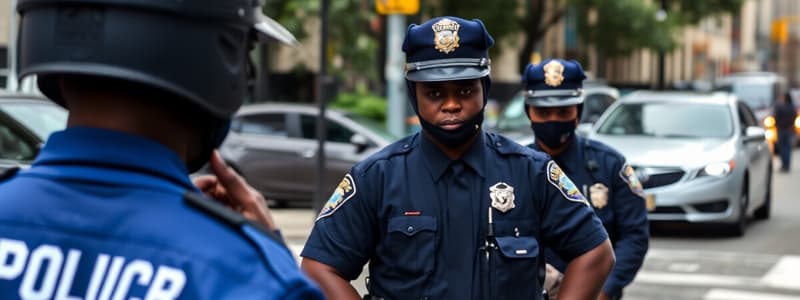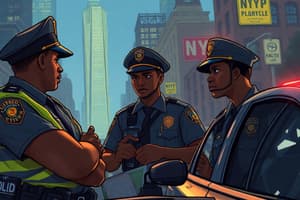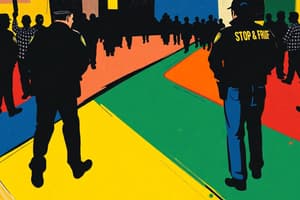Podcast
Questions and Answers
Which demographic group accounted for the highest proportion of reported stops relative to their population representation?
Which demographic group accounted for the highest proportion of reported stops relative to their population representation?
- Adult black and Latino males
- Young white males
- Elderly black and Latino females
- Young black and Latino males (correct)
What is the relationship between the number of stop-and-frisk incidents and the demographic composition of the neighborhoods?
What is the relationship between the number of stop-and-frisk incidents and the demographic composition of the neighborhoods?
- Stop-and-frisk practices disproportionately target black and Latino individuals regardless of neighborhood demographics. (correct)
- Higher racial diversity leads to fewer stops.
- Neighborhoods with lower black and Latino populations have a higher rate of stops.
- Neighborhood composition has no impact on stop-and-frisk practices.
What was the highest reported reason for stops between 2014 and 2016?
What was the highest reported reason for stops between 2014 and 2016?
- Furtive movement
- Suspicious bulge
- Casing a victim or location
- Fits a relevant description (correct)
Which reason for stops became the most common in 2017?
Which reason for stops became the most common in 2017?
In 2017, what stopped being an option on stop forms?
In 2017, what stopped being an option on stop forms?
What percentage of stops in 2017 were reported due to 'Concealing or possessing a weapon'?
What percentage of stops in 2017 were reported due to 'Concealing or possessing a weapon'?
What was the most common stop justification provided by officers for over a decade?
What was the most common stop justification provided by officers for over a decade?
What percentage of reported stops did black and Latino males aged 14 to 24 account for between 2014 and 2017?
What percentage of reported stops did black and Latino males aged 14 to 24 account for between 2014 and 2017?
How many reported stops did the NYPD conduct between 2002 and 2017?
How many reported stops did the NYPD conduct between 2002 and 2017?
In what year were the reported stops at their highest?
In what year were the reported stops at their highest?
What percentage of young black and Latino males were found to be innocent during police stops?
What percentage of young black and Latino males were found to be innocent during police stops?
Which administration reported significantly fewer stops, from 2010 to 2013 compared to the previous four years?
Which administration reported significantly fewer stops, from 2010 to 2013 compared to the previous four years?
What was the number of stops reported in the year 2017?
What was the number of stops reported in the year 2017?
Which statement about the racial dynamics in the use of force is true?
Which statement about the racial dynamics in the use of force is true?
Between 2014 and 2017, what was the overall trend in the use of force among different racial groups?
Between 2014 and 2017, what was the overall trend in the use of force among different racial groups?
Flashcards are hidden until you start studying
Study Notes
Stop and Frisk - Overview
- The NYPD has conducted over 5 million stop and frisk operations since 2002.
- Stop and frisk has declined significantly since the peak in 2011.
- There was a 98% decrease in stop and frisk operations from 2011 to 2017.
- Between 2014 and 2017, young black and Latino men accounted for 38% of all stop and frisk operations despite making up only 5% of the city’s population.
- In 2017, “matches a specific suspect description” became the most common reason for a stop.
Stop and Frisk - Precinct Breakdown
- The precinct with the highest percentage of stops compared to its resident population was the Midtown South Precinct which covers Times Square.
- The precinct with the highest percentage of stops based on force used was the 44th Precinct in the Bronx.
- The precinct with the lowest percentage of stops based on force used was the 66th Precinct in Brooklyn.
Stop and Frisk - Racial Breakdown
- It is more likely for a black or Latino person to have force used against them during a stop and frisk operation compared to a white person.
- Between 2014 and 2017 - 21,776 black and Latino people and 2,293 white people had force used against them.
- This is not attributed to simply more black and Latino people being stopped - the NYPD data reveals that even among those stopped, black and Latino people are more likely to have force used against them than white people.
Studying That Suits You
Use AI to generate personalized quizzes and flashcards to suit your learning preferences.




